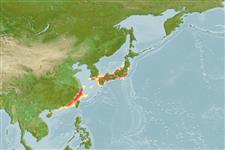Environment: milieu / climate zone / depth range / distribution range
Écologie
marin démersal; profondeur 60 - 123 m (Ref. 75057). Subtropical
Northwest Pacific: China and Japan (Ref. 75057).
Taille / Poids / Âge
Maturity: Lm ? range ? - ? cm
Max length : 4.0 cm SL mâle / non sexé; (Ref. 75057)
Description synthétique
Morphologie | Morphométrie
Épines dorsales (Total): 7; Rayons mous dorsaux (Total): 112; Épines anales 1; Rayons mous anaux: 11. This species is distinguished from its congeners by the following set of characters: 11-12 (usually 11) segmented rays on second dorsal fin; 26-27 (-30?) longitudinal scale count; predorsal scales absent; 8 transverse scales from origin of second dorsal fin backward and downward to anal-fin base; pectoral-fin base naked; anterior 3 spines of first dorsal fin usually elongate and filamentous, extending posteriorly to base of first, second or third segmented ray of second dorsal fin; connecting membrane between innermost rays well developed; when fresh: irregular shaped yellow (pale in preservative) markings on cheek and operculum, oblique narrow yellow line from posterior end of eye to nape, small bright yellowish red spot on center or anteroventral part of operculum, ca. 9 narrow yellow vertical bars on body, distal tip of first dorsal fin vivid red, and a narrow yellow longitudinal band on middle of anal fin (Ref. 75057).
Life cycle and mating behavior
Maturité | Reproduction | Frai | Œufs | Fécondité | Larves
Eschmeyer, W.N. (ed.), 2006. Catalog of fishes. Updated database version of April 2006. Catalog databases as made available to FishBase in April 2006. (Ref. 56787)
Statut dans la liste rouge de l'IUCN (Ref. 130435)
Menace pour l'homme
Harmless
Utilisations par l'homme
Plus d'informations
PaysZones FAOÉcosystèmesOccurrencesIntroductionsStocksÉcologieRégime alimentaireÉléments du régime alimentaireConsommation alimentaireRation
Noms communsSynonymesMétabolismePrédateursÉcotoxicologieReproductionMaturitéFraiRassemblement de ponteFéconditéŒufsDéveloppement de l'œuf
Taille/ÂgeCroissanceLongueur-poidsLongueur-longueurFréquences de longueursMorphométrieMorphologieLarvesDynamique des populations larvairesRecrutementAbondanceBRUVS
RéférencesAquacultureProfil d'aquacultureSouchesGénétiqueElectrophoresesHéritabilitéPathologiesTraitementNutrientsMass conversion
CollaborateursImagesStamps, Coins Misc.SonsCiguateraVitesseType de nageSurface branchialeOtolithesCerveauxVision
Outils
Articles particuliers
Télécharger en XML
Sources Internet
Estimates based on models
Phylogenetic diversity index (Ref.
82804): PD
50 = 0.5000 [Uniqueness, from 0.5 = low to 2.0 = high].
Bayesian length-weight: a=0.00912 (0.00295 - 0.02818), b=2.98 (2.72 - 3.24), in cm total length, based on LWR estimates for this (Sub)family-body shape (Ref.
93245).
Niveau trophique (Ref.
69278): 3.2 ±0.3 se; based on size and trophs of closest relatives
Résilience (Ref.
120179): Haut, temps minimum de doublement de population inférieur à 15 mois (Preliminary K or Fecundity.).
Fishing Vulnerability (Ref.
59153): Low vulnerability (10 of 100).
